Lift off!published at 13:14 BST 14 April 2023Breaking
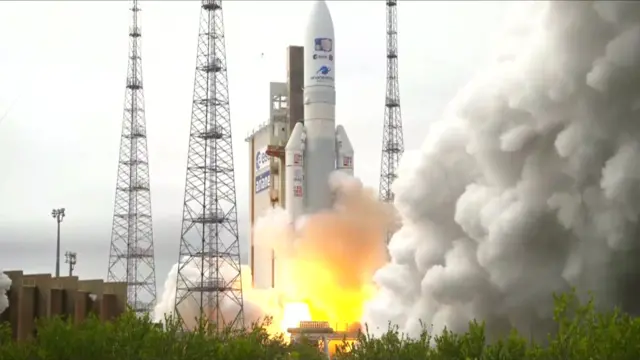
The Ariane 5 rocket has blasted off from its launchpad in Kourou.
The Jupiter moons mission is a go!
The European Space Agency has successfully launched its mission to Jupiter's moons after weather conditions halted yesterday's lift-off
The Ariane 5 rocket launched from the ESA's spaceport in French Guiana at 13:14 BST (09:14 local time) as scheduled
The Jupiter Icy Moons Explorer (Juice) project aims to send a satellite on an eight-year journey to reach the icy moons of the gas giant
The spacecraft will use a gravitational sling-shot technique around Earth and Venus to give it enough energy to reach Jupiter
The £1.4bn (€1.6bn) probe could tell us whether Jupiter's major moons - Ganymede, Callisto and Europa - have the conditions to support simple life
Edited by Jamie Whitehead and Marita Moloney

The Ariane 5 rocket has blasted off from its launchpad in Kourou.
The Jupiter moons mission is a go!
Just seconds to go until lift off
There's only five minutes to go until the Juice mission lifts off from the Earth.
We're holding our breath here after yesterday's postponement - but so far, so good for today's launch.
The ESA has just tweeted: "Final weather check is GREEN. Let’s go to Jupiter!"
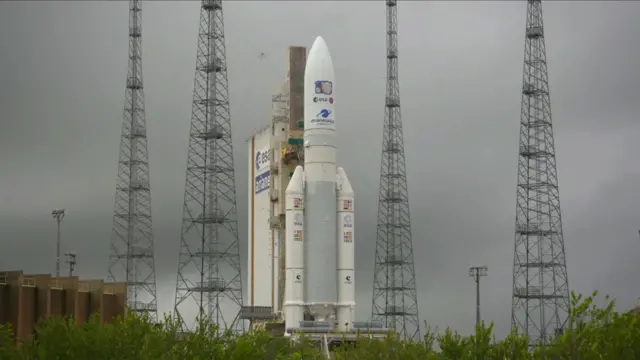
One: The number of seconds that the rocket has to launch - there's only a fleeting window during which the mission can successfully take off.
2031: The year when the spacecraft would arrive at its destination if launched successfully - it will take eight years to make the four billion mile journey.
Fifteen: The number of years some scientists at the European Space Agency have been working on the mission to Jupiter's moons.
1.4 billion: The cost, in pounds, of the mission so far - or €1.6bn; $1.7bn.
13:14: The time in the UK when the Ariane 5 rocket is scheduled to launch from the ESA's spaceport in French Guiana. That's 09:14 local time.
More from the European Space Agency's build-up.
Officials say the satellite's on internal power and the weather "is green".
Things are looking good for take-off in almost ten minutes and you can watch the launch live by pressing the Play button at the top of this page.
In the last few moments, the European Space Agency's operations team has tweeted an update.
"Mission Control is go," it says, external.
It is worth keeping in mind that yesterday's launch was called off eight minutes before the scheduled take off time.
We'll keep a close eye on how things develop, but for now the situation looks promising with less than half an hour to go.
 Jonathan Amos
Jonathan Amos
Science correspondent, BBC News
After the risk of lightning halted yesterday's lift off, it's worth looking at why such a site - with its changeable weather - has been chosen for launch.
Crucially, it's on the equator. This means you get maximum help from the rotation of the Earth, which means you can launch a larger payload for the same amount of "oomph" from your rocket.
A rocket setting off from there will have an advantage over other rockets setting off from space centres in the US or Russia, for example.
Rockets can handle a fair amount of wind, but the wind's direction is also a key factor the team will pay attention to.
One of the issues they have is that, if the rocket had to be destroyed mid-flight - for example if it were going off course - they would not want the wind to blow debris back onto the coast.
All eyes will be on the weather around the launch site at Kourou, especially after conditions forced the first attempt to be halted.
Officials said they wouldn't take any risks, but as BBC weather presenter Louise Lear explains, there is still a slight chance of more storms in the morning around French Guiana's launch pad.
You can see a forecast for the area below.
 Thomas Mackintosh
Thomas Mackintosh
Live reporter
Earlier I spoke to British meteorologist Rebecca Smith who is out in Kourou.
She spoke about the build-up, atmosphere and weather conditions yesterday and I've asked her how things are looking today.
"I get the impression people are tentative," she says. "It has been raining all night, it is quite overcast - and conditions look quite similar.
"I think there is still hope it will happen. People want to be excited, but people are a bit reserved."
 Jamie Whitehead
Jamie Whitehead
Live reporter
Welcome (again!). We’re once more gearing up for the launch of the European Space Agency's ambitious mission to study Jupiter and its icy moons.
Will it definitely happen today? We don't know. It's tense. Yesterday's attempt to send the £1.4bn (€1.6bn) probe off into space was called off minutes before lift-off because of the risk of lightning - and the weather is not looking great in Kourou at the moment.
There is just a one-second window for the spacecraft to set off on its very specific journey, which will use gravity from fly-bys of Venus and Earth to slingshot it out towards Jupiter.
It's also a little mind-boggling. The Jupiter Icy Moons Explorer - Juice for short - will take eight years to reach its destination. And there - far out in the cold, dark depths of the Outer Solar System - scientists believe hidden oceans on some of the gas giant's moons might have the conditions to support simple forms of life.
The launch is scheduled for 13:14 BST. I'm here with Marita Moloney, Thomas Mackintosh, Ece Goksedef and Aoife Walsh, and together with science correspondent Jonathan Amos and science editor Rebecca Morelle we'll be bringing you live updates and analysis.
We're pausing our coverage today - after all that build up and then a fairly abrupt halt because of weather conditions just minutes before the scheduled launch.
As we've been reporting, much of today has been looking ahead to one of the European Space Agency's biggest ever missions - sending a satellite to Jupiter to explore whether its ocean-bearing moons can support life.
But, because of lightning risks at the launch site in Kourou, French Guiana, today's launch has been called off. You can read more here.
The next launch window is expected to be at 13.14 BST tomorrow, so we hope to be back then with more build-up, more analysis and hopefully a rocket in the sky!
Today's coverage was brought to you by Heather Sharp, Malu Cursino, Thomas Mackintosh, Emma Owen and our science correspondent Jonathan Amos and science editor Rebecca Morelle.
Moment ESA hosts hear launch is cancelled
 Jonathan Amos
Jonathan Amos
Science correspondent, BBC News
Disappointing but that's rocketry.
Some days you go on the dot; other days some technical or weather-related gremlin gets in the way. It makes no difference to the mission itself.
It's an eight-year journey to the Jovian system and another day will be of no consequence.
The weather in Kourou is absolutely bizarre on certain occasions, blinding sun one minute and the next you can be absolutely drenched in tropical downpour - and it can switch backwards and forwards.
What you don't need is electrical activity going up through the atmosphere to complicate matters for you, so it's safer to stay on the ground.
The important thing is that all systems are safe.
The control rooms in Kourou will leave the Ariane out on the pad - fingers crossed we'll come back tomorrow or the day afterwards for a successful launch.
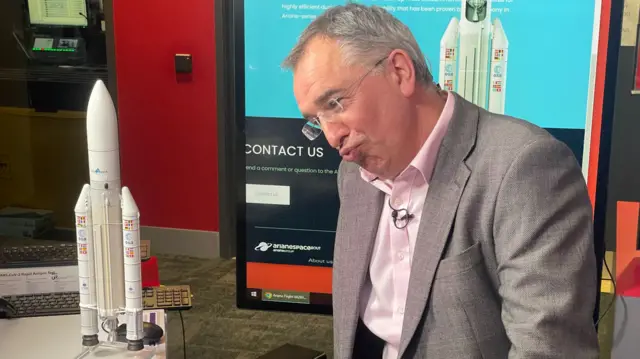
Once again, our science correspondent Jonathan Amos has had to sit through a failed launch.
Here he is at his desk - we'll hear from him in a minute. He's just gathering his thoughts.
We've had some images from inside the Guiana Space Centre in French Guiana.
Among the scientists and onlookers were some members of the Belgian Royal Family.
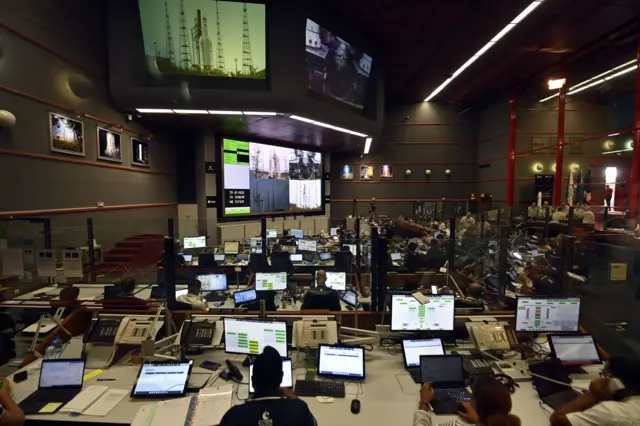 Image source, Getty Images
Image source, Getty ImagesThe team will attempt to launch the satellite again tomorrow
 Image source, Getty Images
Image source, Getty ImagesPrince Gabriel and King Philippe of Belgium were there for the launch that wasn't to be
 Image source, Getty Images
Image source, Getty ImagesThis image gives a glimpse of the complex calculations that go on behind the scenes head of a launch
On this side of the Atlantic, astronomer Dr Jenifer Millard has been reflecting on the announcement.
Speaking from Cardiff she says: "Lightning is the last thing you need on a box full of electronics.
"It is just not worth it - this mission has been in the making for more than a decade.
"So much research and money has gone into this, it's just not worth the risk.
"It'll be a slightly different time tomorrow, they'll try again tomorrow - and then the next day, then the next day until this thing goes!"
The European Space Agency is covering the event in its own YouTube channel, and that's where we found out just a few moments ago that the launch has been postponed.
It says it will try again tomorrow, with Airanespace tweeting, external that the rocket will aim to lift off at 09:14 local time from French Guiana, 13:14 BST.
"It's beyond our control," the host explained on the channel.
There are two key weather risks scientists look out for: high altitude winds and risk of lightning. Grounding lift off today was, unfortunately, the risk of lightning.
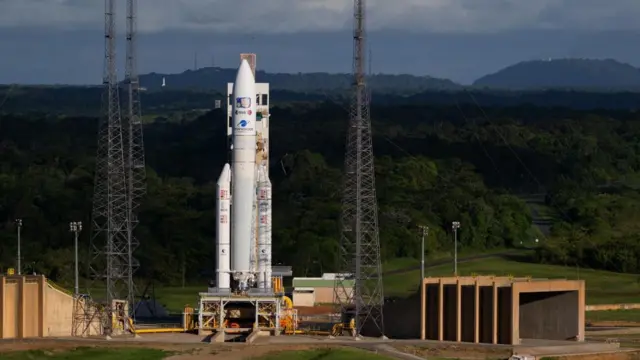 Image source, Getty Images
Image source, Getty ImagesThis picture, taken last night, shows dark skies at the launch site in French Guiana, and today the final checks on the weather showed there was a risk of lightning.
Scientists say they'll try again tomorrow.
We've just had an announcement which says the lift off has been postponed because of weather conditions.
As we've been reporting, the pressure is on as the mission has a one second window to launch - rapidly approaching in about 10 minutes' time.
Once the Ariane 5 rocket takes off, there'll be a series of key moments and we'll be watching carefully.
In the first few minutes of the flight, the solid rocket fuel boosters along the sides of the rocket will do the heavy lifting to get the spacecraft off the ground. These will then fall away.
Less than half an hour after lift off, the other stages of the rocket will also have separated.
The European Space Agency (ESA) predicts the earliest expected time for the team on the ground to acquire a signal from the Juice satellite is roughly 36 minutes after lift off.
Then the satellite's large solar array will open out - with its deployment expected to be completed roughly 100 minutes after lift off.

 Rebecca Morelle
Rebecca Morelle
Science editor
 Image source, ESA
Image source, ESAA voyage to the outer solar system requires patience - a lot of patience.
Many of the scientists involved with Juice have already been working on this for 15 years.
That’s the time it takes for a mission to be proposed and designed - for scientists to figure out exactly what questions they want to answer - and for a spacecraft and its instruments to be built.
The launch is the crucial next step - but we’re only at the mission's midway point.
After that there’s an eight-year journey ahead before Juice reaches its destination in 2031.
For a few years the spacecraft will be orbiting Jupiter, performing close flybys of Jupiter's moons - but in 2034 it will get into orbit around Ganymede, before the mission comes to an end in 2035.
By then scientists will only just be starting to get to grips with the data that’s been sent back - their work on trying to understand these mysterious moons will continue even further into the future.